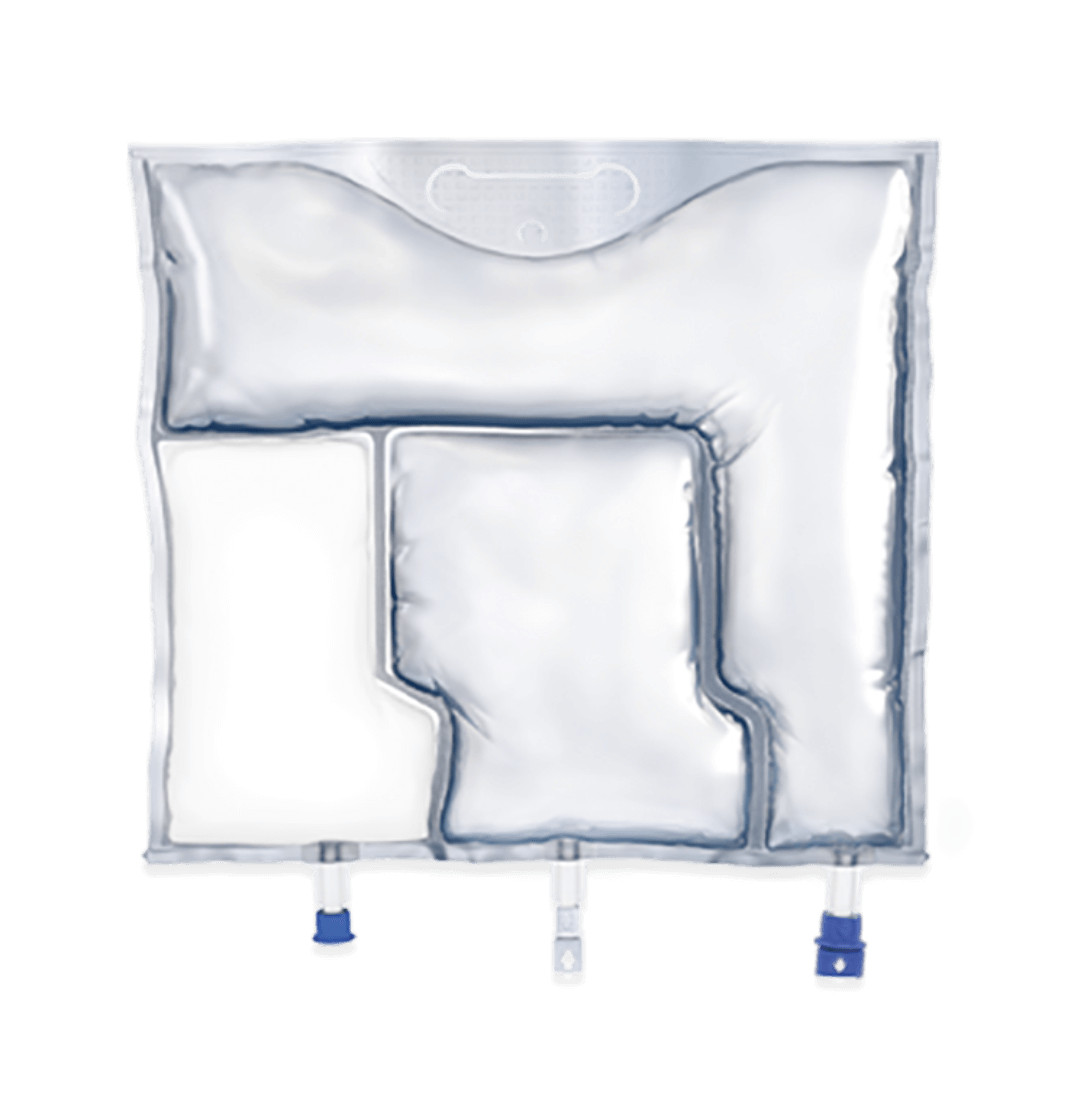

Multi-chamber bags (MCBs): streamlining parenteral nutrition (PN)
MCB products can be options for many adult patients who require PN. In fact, these innovations are widely used in Europe.1 MCB-PN products are becoming more popular in the US, possibly because they help address the need for compounded clinical nutrition alternatives during PN product shortages and offer the potential to reduce pharmacy staff time and costs.*2-6 Let’s take a look at what MCB-PN products are, explore their features, review safety concerns, and more.
A clinical guidelines recommendation from the American Society for Parenteral and Enteral Nutrition (ASPEN) states, “We suggest that commercially available premade multichambered PN formulations be considered as an available option for patients alongside compounded (customized or standardized) PN formulations to best meet an organization’s patient needs.”6
What is MCB-PN?
MCB-PN products are available as 2- and 3-chamber bags, each designed with a unique formulation to help support the various nutrition needs of many patients requiring PN.7-9
![]()
A 2-chamber bag (2CB) features 2 separate compartments—one for dextrose and one for amino acids. Lipid injectable emulsions may be added to the bag, and formulations are available with or without electrolytes.7
![]()
A 3-chamber bag (3CB) features 3 separate compartments for dextrose, amino acids with electrolytes, and a soybean oil-based lipid emulsion. Currently, there are no electrolyte-free versions available in the US.8,9
However, their use may not be appropriate for patients with high gastrointestinal tract output, severe electrolyte abnormalities, or in those who require more amino acids and calories that cannot be provided with MCB-PN alone.*10 These patients may require customized formulations to help them meet their unique nutrition requirements.

Fresenius Kabi’s 3CB formulations—Kabiven® (Amino Acids, Electrolytes, Dextrose, and Lipid Injectable Emulsion), for intravenous use, and Perikabiven® (Amino Acids, Electrolytes, Dextrose, and Lipid Injectable Emulsion), for intravenous use—help clinicians efficiently deliver 3 macronutrients (dextrose, protein, and lipids) plus electrolytes in volumes and concentrations that meet the needs of many adult patients by reducing waste.5,8,9 These products are the first and only of their kind available for adults in the US.8,9
Please see Important Safety Information below.
What are the features of Fresenius Kabi’s 3CB-PN products?
3CB-PN products require fewer compounding steps compared with manual compounding.2 They are also designed for convenience by mixing nutrients in a single bag, facilitating standardized PN processes.2 The features of our very own 3CB products, Kabiven and Perikabiven, may help:
![]()
Simplify setup: No need to piggyback or add lipids manually
![]()
Streamline delivery: All-in-one formulation delivers macronutrients and electrolytes simultaneously, eliminating the need for Y-site infusion
![]()
Add flexibility: Two formulations to help meet adult patients’ unique needs — Kabiven for central PN and Perikabiven for peripheral or central PN8,9
![]()
Save time and costs: 3CBs may be associated with reduced pharmacy staff time, workload, and costs compared with hospital-compounded bags (HCBs)5
A time and motion study evaluated time, labor, and cost savings of 3CBs compared with HCBs.
In a multicenter, prospective, time and motion study evaluating PN delivery systems, the 3CB delivery system was associated with a 62% reduction in pharmacy staff time and workload as well as a 37% reduction in costs compared with HCBs (representing PN prepared with automated compounding devices). The cost per bag included labor, PN products, medical consumables, and equipment. One hundred thirty-six PN prescriptions were prepared during the study (66 for 3CBs and 70 for HCBs). The clinical efficacy of 3CBs versus compounded PN was not evaluated.5
Are there any safety concerns associated with MCB-PN?
Although MCB-PN requires fewer compounding steps, there are safety issues to keep in mind once the bags are activated. For example, the length of stability and storage conditions vary, depending on the absence or addition of additives.8,9,11,12
While MCB-PN can be an option for many patients requiring PN, it’s important to consider several factors to determine if these products could be a good fit for your facility.
Check out this ASPEN practice tool to learn more about the use of MCB-PN.
As the global leader in 3-chamber bags† and US market leader in lipid injectable emulsions,13 Fresenius Kabi is proud to offer Kabiven and Perikabiven as options for PN.
See how Kabiven’s and Perikabiven’s unique designs help streamline the delivery of nutrition therapy to adult patients and may simplify calculations, prescription writing, compounding, and administration: www.FreseniusKabiNutrition.com/products/kabiven-perikabiven/
KABIVEN (Amino Acids, Electrolytes, Dextrose, and Lipid Injectable Emulsion), for intravenous use PERIKABIVEN (Amino Acids, Electrolytes, Dextrose, and Lipid Injectable Emulsion), for intravenous use
IMPORTANT SAFETY INFORMATION
What is Kabiven and Perikabiven?
- Indicated in adult patients as a source of calories, protein, electrolytes and essential fatty acids for parenteral nutrition when oral or enteral nutrition is not possible, insufficient, or contraindicated. Kabiven and Perikabiven may be used to prevent essential fatty acid deficiency or treat negative nitrogen balance in adults.
- Do not exceed the recommended maximum infusion rate of 2.6 mL/kg/hour for Kabiven and 3.7 mL/kg/hour for Perikabiven.
Limitations of Use
Neither Kabiven nor Perikabiven is recommended in pediatric patients less than 2 years old because the fixed amount of the formulations do not meet nutritional needs in this age group.
Do not use Kabiven or Perikabiven in patients who have:
- Simultaneous treatment with ceftriaxone in neonates (28 days of age or younger)
- Known allergy to egg, soybean, peanut or any of the active or inactive ingredients
- Abnormally high levels of lipid (triglycerides) in the blood (with serum triglyceride concentration >1,000 g/dL)
- Inborn errors of amino acid metabolism (a genetic defect in protein metabolism)
- Cardiopulmonary instability (inability for the heart and lungs to function right)
- Hemophagocytic syndrome (a disorder of the immune system)
Kabiven and Perikabiven may cause serious side effects including:
- Serious Adverse Reactions with Rapid Infusion of Intravenous Lipid Emulsion in Neonates and Infants: Strictly follow the recommended total daily dosage and do not exceed the maximum infusion rate. If poor clearance of fats occurs, the infusion should be stopped, and a medical evaluation started.
- Risk of Parenteral Nutrition-Associated Liver Disease: Increased risk in patients who receive parenteral nutrition for greater than 2 weeks. Your healthcare provider will monitor liver tests.
- Pulmonary Embolism (a blockage in a blood vessel in the lung) and Respiratory Distress (increased breathing rate, bluish skin color changes, wheezing) due to Pulmonary Vascular Precipitates (solid substance in the blood vessel of the lungs): If signs of lung issues occur, stop the infusion and start a medical evaluation.
- Allergic Reactions: Contact your healthcare provider immediately if you are experiencing an allergic reaction
- Precipitation (solid substance in the blood vessel) with Ceftriaxone: Do not administer ceftriaxone simultaneously with Kabiven or Perikabiven via a Y-site.
- Infection, fat overload, hyperglycemia (high blood sugar) and refeeding syndrome: Your healthcare provider will monitor you for signs and symptoms of early infection and blood levels
The most common adverse reactions for Kabiven (≥3%) are nausea, fever, high blood pressure, vomiting, decreased blood hemoglobin, decreased blood total protein, low blood potassium, and increased gamma glutamyltransferase (a liver enzyme). The most common adverse reactions for Perikabiven (≥3%) are high blood sugar, low blood potassium, fever and increased blood lipids.
To report SUSPECTED ADVERSE REACTIONS, contact Fresenius Kabi USA, LLC at 1-800-551-7176, option 5, or FDA at 1-800-FDA-1088 or www.fda.gov/medwatch.
Tell your doctor if you are taking coumarin and coumarin derivatives, including warfarin: the drug activity may be lessened and your healthcare provider will monitor your blood.
These are not all the possible side effects associated with Kabiven and Perikabiven. Call your healthcare provider for medical advice regarding Kabiven and Perikabiven side effects. You are encouraged to report negative side effects of Kabiven and Perikabiven. Contact Fresenius Kabi USA, LLC at: 1-800-551-7176 or FDA at: 1-800-FDA-1088 or www.fda.gov/medwatch. The FDA-approved product labeling can be found at www.FreseniusKabiNutrition.com/KabivenPI and www.FreseniusKabiNutrition.com/PerikabivenPI.